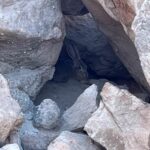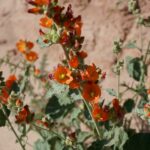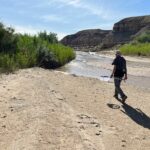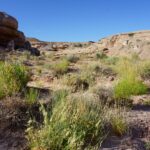Journalist Report
MDRS Crew 282 (Martian Biology III)
Jordan Bimm, 06.07.23
Exploring Mars, NASA’s mantra is “follow the water.” On Earth, wherever we find water, we also find life, and this principle has guided robotic rover missions including Perseverance’s search for evidence of past habitable conditions. Today the crew took the MDRS rovers Spirit, Opportunity, and Perseverance to collect biological samples at two sites where water is key: White Canyon and the Fremont River. White Canyon is an ecologically diverse canyon with unique features called seeps along its southern edge. Seeps are places kept moist and lush by water that reaches the surface from underground aquifers, which in the desert surrounding MDRS makes White Canyon an ideal oasis-like place to search for life. (For those familiar with the Station, White Canyon is located near the turn-off from Utah State Road 24 that leads to MDRS.) Last year, during Martian Biology II, we explored this site for the first time and flagged it as one worth returning to for more coverage. Today we collected more plants including Small-leaf Globemallow (Sphaeralcea parvifolia), discovered tadpole larvae in a small pool of standing water, and spotted some whiptail lizards (Teiidae) as well as a White-tailed Jackrabbit (Lepus townsendii) sheltering from the blazing sun in a small, cool crevasse between rocks. We followed White Canyon to a culvert that leads under Utah State Road 24 and to the banks of the Fremont River, which flows in the direction of nearby Hanksville. Back on Day 1 of our mission, Jacapo, our entomologist, had set a special trap for mosquito larvae here since these pesky insects love to lay their eggs in water. Today was our first chance to check and see if it had worked. We located the trap, which was still in good shape, but unfortunately it did not contain the hoped-for mosquito larvae. Astrobiologists know all too well the disappointment in not finding life you are hoping to discover. But in science negative findings are productive results, so Jacopo decided to make some alterations to the experimental setup, and we will check back on it again later in the mission.
Image 1: White Canyon is a consolidated sandstone gully leading to the Fremont River at the southern edge of the MDRS exploration zone.
Image 2: Sphaeralcea parvifolia (Small-leaf Globemallow) flowering in White Canyon, south of MDRS.
Image 3: A White-tailed jackrabbit we spotted in a shady crevasse in White Canyon.
Image 4: Jacopo checking in on mosquito larvae traps on the Fremont River.






You must be logged in to post a comment.